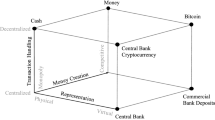Abstract
The low success rate of lending is the main drawback of development of online P2P lending platforms in China. Based on the theory of social capital, this study analysed the influence factors of success rate of P2P lending platform in China, using social network method and multiple linear regression model. Soft information, such as bidding record, has been creatively employed to study the corresponding topics. Data used in this study comes from the largest online P2P lending platform in China. The results show that: compared with other influence factors, the bidding record has a more significant effect on the success rate, and the users depend more on the social capital; the bidding records reduce the asymmetry of information, and help increasing the success rate of lending and decreasing the cost of online P2P lending.




Similar content being viewed by others
References
Bandura A (1982) Self-efficacy mechanism in human agency. Am Psychol 37(2):122
Hartenstein M, Andrews RL, Dholakia U et al (2008) The democratization of personal consumer loans? Determinants of success in online peer-to-peer lending communities [J], vol 14. Boston University School of Management Research Paper
Bachmann A, Becker A, Buerckner D et al (2011) Online peer-to-peer lending-a literature. J Internet Bank Commer 16(2):1–18
Wang H, Greiner M, Aronson JE (2009) People-to-People lending: the emerging E-commerce transformation of a financial market. In: 15th Americas conference on information systems, AMCIS 2009, SIGeBIZ track, San Francisco, 6–9 August 2009
Cu Y, Qiu J, Chen D (2010) School of information Southwestern University of finance and economics, Chengdu, Sichuan, China. P2P lending in different cultures and business models: a multiple case study. In: Fifth China association of international business negotiation Chinese management academic annual-information management parallel session memoir. China Association of International Business Negotiation, p 7
Li S, Qiu J, Lin Z et al (2011) Do borrowers make homogeneous decisions in online P2P lending market? an empirical study of PPDai in China. In: Service systems and service management (ICSSSM), 2011 8th international conference on. IEEE, pp 1–6
Chen D, Hao L, Xu H (2013) Gender discrimination towards borrowers in online P2PLending. In: WHICEB 2013 proceedings, 2013. p 55
Lin M, Prabhala NR, Viswanathan S (2009) Judging borrowers by the company they keep: social networks and adverse selection in online peer-to-peer lending [J]. SSRN eLibrary
Greiner ME, Wang H (2009) The role of social capital in people-to-people lending marketplaces. In: ICIS 2009 proceedings, 2009. p 29
Greiner ME, Wang H (2010) Building consumer-to-consumer trust in e-finance marketplaces: an empirical analysis. Int J Electron Commer 15(2):105–136
Chen X, Zhou L, Wan D (2016) Group social capital and lending outcomes in the financial credit market: an empirical study of online peer-to-peer lending. Electron Commer Res Appl 15:1–13
Berger SC, Gleisner F (2011) Emergence of financial intermediaries in electronic markets: the case of online P2P lending. Bus Res 2(1):39–65
Xu Y, Qiu J, Lin Z (2011) How does social capital influence online P2P lending? a cross-country analysis. In: Management of e-Commerce and e-Government (ICMeCG), 2011 Fifth international conference on. IEEE, pp 238–245
Chen D, Han C (2012) A comparative study of online P2P lending in the USA and China [J]. J Internet Bank Commer 17(2)
Freedman S, Jin GZ (2014) The signaling value of online social networks: lessons from peer-to-peer lending [M]. Natl Bureau Econ Res
Liu D, Brass D, Lu Y et al (2015) Friendships in online peer-to-peer lending: pipes, prisms, and relational herding [J]. MIS Quarterly, 39(3):729–742
Lin M (2009) Peer-to-peer lending: an empirical study. In: AMCIS 2009 doctoral consortium, 2009. p 17
Iyer R, Khwaja AI, Luttmer EFP et al (2009) Screening in new credit markets: can individual lenders infer borrower creditworthiness in peer-to-peer lending?. In: AFA 2011 Denver meetings paper, 2009
Yang L, Lai VS (2014) Performance as a signal to information asymmetry problem in online peer-to-peer lending. In: PACIS 2014 proceedings, 2014, paper 389
De Nooy W, Mrvar A, Batagelj V (2011) Exploratory social network analysis with Pajek. Cambridge University Press, Cambridge
Acknowledgements
This study was supported by the National Natural Science Foundation of China (Nos. 61309029, 61273293) and Ministry of Education Humanities Social Sciences Research Project (No. 11YJC880163)and Discipline Construction Foundation of Central University of Finance and Economics. We would like to thank Doctor Hu Yang for his valuable comment and suggestions.
Author information
Authors and Affiliations
Corresponding author
Rights and permissions
About this article
Cite this article
Yang, Z., Zhang, Y. & Jia, H. Influencing Factors of Online P2P Lending Success Rate in China. Ann. Data. Sci. 4, 289–305 (2017). https://doi.org/10.1007/s40745-017-0103-6
Received:
Revised:
Accepted:
Published:
Issue Date:
DOI: https://doi.org/10.1007/s40745-017-0103-6




